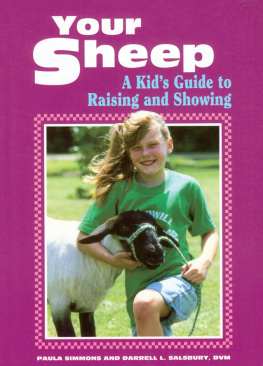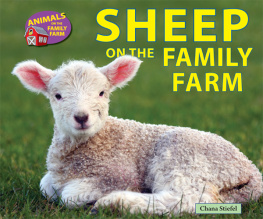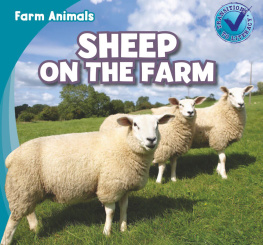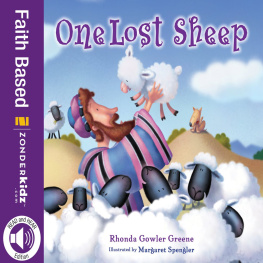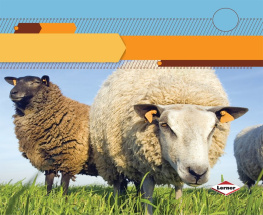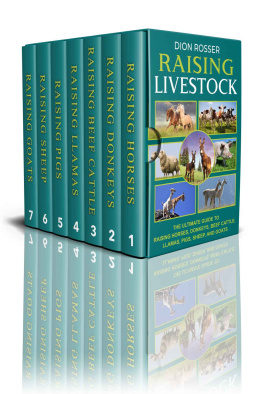Your Sheep
A Kids Guide to Raising and Showing
PAULA SIMMONS
AND
DARREL L. SALSBURY, DVM
The mission of Storey Publishing is to serve our customers by publishing practical information that encourages personal independence in harmony with the environment.
Cover and text design by Carol Jessop
Cover photograph courtesy of sheep! magazine, Helenville, WI 53137
Production by Carol Jessop
Edited by Gwen W. Steege and Lorin A. Driggs
Illustrated by Carol Jessop, except , which are by Elayne Sears
Technical review by William K. Kruesi
Indexed by Kathleen D. Bagioni
Copyright 1992 by Storey Publishing, LLC
Ebook version 2.0
October 3, 2016
All rights reserved. No part of this book may be reproduced without written permission from the publisher, except by a reviewer who may quote brief passages or reproduce illustrations in a review with appropriate credits; nor may any part of this book be reproduced, stored in a retrieval system, or transmitted in any form or by any meanselectronic, mechanical, photocopying, recording, or otherwithout written permission from the publisher.
The information in this book is true and complete to the best of our knowledge. All recommendations are made without guarantee on the part of the author or Storey Publishing. The author and publisher disclaim any liability in connection with the use of this information. Storey books are available for special premium and promotional uses and for customized editions. For further information, please call 1-800-793-9396.
Storey Publishing
210 MASS MoCA Way
North Adams, MA 01247.
www.storey.com
Front cover: Abbie Ferris with her Suffolk-Rambouillet.
Library of Congress Cataloging-in-Publication Data
Simmons, Paula.
Your sheep: a kids guide to raising and showing / by Paula Simmons and Darrell L. Salsbury.
p. cm.
Includes bibliographical references and indexes.
ISBN-13: 978-0-88266-769-0 (pbk.)
ISBN-10: 0-88266-769-6 (pbk.)
1. SheepJuvenile literature. 2. SheepShowingJuvenile literature. [1. Sheep.] I. Salsbury, Darrell L., 1936- . II. Title.
SF375.2.S56 1992
636.3dc20
91-57947
CIP
AC
Contents
Appendixes
Sheep Calendar: A Record of What to Do Each Month
A Few Words to Parents
Any animal project that your child takes on is likely to entail a certain amount of your own time, effort, and expense. A livestock project can do much, however, to teach your child to take responsibility, to make decisions, and to be dependable and observant. These are the very skills and attitudes needed for a smooth transition from childhood to adolescence to young adulthood. The work of properly caring for sheep builds character. Perhaps for the first time, a young shepherd must accept the responsibility for the welfare of another living creature that cannot fend for itself. This responsibility develops self-confidence borne of pride in the knowledge of a job well done. Children who undertake the care of an animal attain qualities of patience and maturity beyond their peer group.
Your son or daughter will at times need adult advice and supervision, and in some instances, help with the actual work. Many jobs require two pairs of hands, and even adult shepherds need assistance from time to time.
Such groups as local 4-H clubs, Future Farmers of America (FFA), Boy Scouts, and Girl Scouts can provide much guidance. Kids can learn a great deal as they become actively involved in the many activities of these organizations. A physical disability need not prevent participation. In Georgia, for instance, a specific 4-H lamb project has been established for physically or mentally disabled youths. Each special youth has a fellow club member as a partner to assist with the care, handling, and shearing of lambs.
If you are not an experienced shepherd, your role will be made easier if a 4-H leader is supervising the choice, purchase, and care of the sheep. Other sources of advice are Agricultural Cooperative Extension agents, local sheep producers, or your local veterinarian. Where this is not possible, your childs sheep-raising project could be a learning process for the whole family. Whatever the case, enter into it in the spirit of fun and adventure. It helps to keep your sense of humor.
Introduction
One of the great things about sheep is that they are much easier to handle than a lot of other farm animals, such as cows, horses, and pigs. They dont take much room, theyre fairly easy to care for, and they can be trained to follow, come when called, and stand quietly at a show. All of these features make sheep excellent animals for young people to own and raise.
Sheep are clean, gentle, fun, easy to care for, and, above all, affectionate.
sheep! Magazine, photo by Martha H. Frischkorn
Sheep-ish History
Did you know that sheep have been the most important domestic animal in the world for over 10,000 years?
Almost as far back as the cave dwellers, people considered sheep to be one of the most important animals in the world because they could produce three things people needed for survival: milk, meat, and clothing.
For many centuries, all over the world, the traditional shepherds have been young people. The biblical King David was a shepherd as a child. Storybook characters like the boy who cried wolf, Little Bo Peep, and Mary, who had a little lamb, are well known to us all. Grade-school-age kids often have full responsibility for a flock of sheep. Whether its herding them from pasture to pasture, helping with the lambing, bringing them in for the shearing, or guarding them from predators, children in many different countries have long been the shepherds of the earth.
Sheep Are Earth-Friendly
In many special ways, sheep do good things for people and for the place in which they live. And they need surprisingly little in return. Land that is too dry or too poor for growing vegetables, fruits, or grains is fine for sheep. They can eat weeds, grasses, brush, and other plants that grow on poor land.
Some people argue that it is wrong to feed grain to sheep when so many human beings dont have enough to eat. But parts of food plants like corn, rice, and wheat are too tough to be eaten by people. Sheep are able to eat those tough parts because their digestive systems are designed to handle just that sort of thing.
Sheep provide many things that we can eat or wear. Many of the worlds most popular cheeses are made from sheep milk. Sheep wool, which can be used for rugs and blankets, as well as for clothing, is a renewable resource. This means that each year, right after the sheep is sheared, it begins right away to grow new fleece.
Sheep also help the soil. If you spread their manure over your garden, it will fertilize the soil, and your plants will grow strong and healthy.
If you decide to grow sheep for meat, you can also use the pelt (skin) to make clothing, and you can make candles and soap from the fat.
CHAPTER 1
Getting to Know Sheep
Sheep depend on their owners for food, protection from predators, and regular shearing, but they require less special equipment and housing than any other livestock. One or two lambs or

